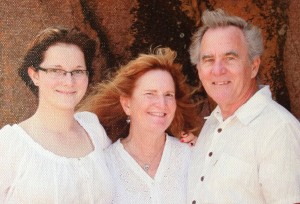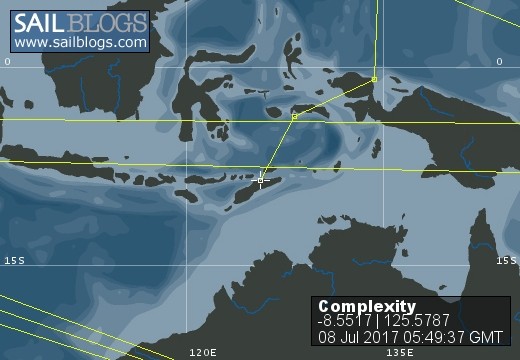
Travels with Complexity
16 September 2019 | Pangkor Marina, Malaysia
08 July 2017 | Dili, Timor-Leste
02 July 2017 | Ambon, Indonesia
08 June 2017 | Sorong, Indonesia, at anchor on South Side of Doom Island
06 May 2017 | Royal Belau Yacht Club mooring, Malakal Palau
05 May 2017 | Malakal, Palau
05 May 2017 | Malarial, Palau off Sam's Tours
13 April 2017 | Royal Belau Yacht Club, Malakal, Palau
12 April 2017 | Royal Belau Yacht Club, Malakal, Palau
15 March 2017 | Rock Islands, Palau
14 March 2017 | Coffin Anchorage, Rock Islands, Palau
13 March 2017 | Fish Net Anchorage, Rock Islands, Palau
04 February 2017 | Malakal, Palau
21 December 2016 | Malakal Port, Palau
20 December 2016
18 December 2016
17 December 2016
17 December 2016
15 December 2016
14 December 2016
Rainy Day Projects
13 April 2017 | Royal Belau Yacht Club, Malakal, Palau
By Barbara on a rainy day

One of the sweetest moments on any sailboat is when you turn off the engine. So, it is annoying when we have to turn on the engine to top off our batteries at anchor or on passage when sailing. We enjoyed plugging into the "mother ship" when our friend's big fly bridge cruiser was rafted alongside and running two generators or having shore power in marinas, but otherwise prefer to be at anchor or on a mooring. Running the engine for an hour and sometimes MUCH LONGER also adds heat to the already unbearably hot boat, is noisy, burns diesel fuel which is often hard to come by and pollutes the air.
Our boat to date has been equipped with a Eclectic Energy D400 wind generator and two 75-watt solar panels which Jim installed years ago while we were living in Australia. My engineer is never happier than when adding or upgrading systems on our boat which was ostensibly ready to go when we bought her almost twenty years ago. His major project during our time in Palau has been to add new and more efficient solar panels and to service our wind generator.
The first major step was to research the best options for our boat. He needed to identify and source the most efficient solar panels that could be made to fit on our targa. After deciding which solar panels he wanted the next step proved to be the most difficulty, getting them shipped to Palau. Our four new 160-watt solar panels finally arrived from China along with two more included in the order for a friend on another boat. Jim did the wiring and as much of the structural design work as he could ahead of time.
The next difficult step was procuring the materials to build the support structures for the sides of our stainless steel targa which was custom built in Port Stephens, Australia. We wanted to be able to fold down and secure the two side panels if needed and to remove all four solar panels to stow below in case we ever need to prepare to weather a typhoon, cyclone or hurricane. Jim was able to source most of the materials to build the structures he designed from local hardware stores and the parts stashes aboard our boat and of a generous friend on other boat. He did however have to order from Sailrite in the USA four Bimini fittings for the larger tube sizes in his design. We hope to receive them in a week or two.
Meanwhile Jim has been sawing, building and installing most of the new structures. Yesterday was hot and sunny, but today is rainy and cool (relatively speaking for tropical weather). Hopefully he is capturing all the wee bits of slivered metal and they will not get walked into the teak deck and elsewhere on the boat. Yes, this has happened in the past causing strife among the crew aboard.
When the solar panel project is finished we hope we will only need to turn on our engine when propulsion is required for maneuvering the boat or traveling in light air conditions. Meanwhile, unsurprisingly, Complexity's engineer, of course, needs a few more parts from the local Ace Hardware store.
P.S. I am designing and getting ready to make a white vinyl rain catcher for our foredeck. The white vinyl will be relatively easy to keep clean. A key design feature I desire is that it will also double as a shade over the hammock which we used to rig between the mast and forestay. It has been too bloody hot in the tropics to use the hammock! If successful, the shaded hammock will be a great place to read during the hottest part of the day. A third feature is to shelter our forward hatch so we can leave it open for cooler sleeping on rainy nights. I have also ordered some small UV-resistant coils to capture rain off of our big sunshade which we built while in Australia. We are not so keen to put that water into our tanks and drinking water because the sunshade is almost always deployed and collects bird droppings. The usually, but not always, quite clean water, water would be great in buckets for doing laundry aboard. Stay tuned.
Our boat to date has been equipped with a Eclectic Energy D400 wind generator and two 75-watt solar panels which Jim installed years ago while we were living in Australia. My engineer is never happier than when adding or upgrading systems on our boat which was ostensibly ready to go when we bought her almost twenty years ago. His major project during our time in Palau has been to add new and more efficient solar panels and to service our wind generator.
The first major step was to research the best options for our boat. He needed to identify and source the most efficient solar panels that could be made to fit on our targa. After deciding which solar panels he wanted the next step proved to be the most difficulty, getting them shipped to Palau. Our four new 160-watt solar panels finally arrived from China along with two more included in the order for a friend on another boat. Jim did the wiring and as much of the structural design work as he could ahead of time.
The next difficult step was procuring the materials to build the support structures for the sides of our stainless steel targa which was custom built in Port Stephens, Australia. We wanted to be able to fold down and secure the two side panels if needed and to remove all four solar panels to stow below in case we ever need to prepare to weather a typhoon, cyclone or hurricane. Jim was able to source most of the materials to build the structures he designed from local hardware stores and the parts stashes aboard our boat and of a generous friend on other boat. He did however have to order from Sailrite in the USA four Bimini fittings for the larger tube sizes in his design. We hope to receive them in a week or two.
Meanwhile Jim has been sawing, building and installing most of the new structures. Yesterday was hot and sunny, but today is rainy and cool (relatively speaking for tropical weather). Hopefully he is capturing all the wee bits of slivered metal and they will not get walked into the teak deck and elsewhere on the boat. Yes, this has happened in the past causing strife among the crew aboard.
When the solar panel project is finished we hope we will only need to turn on our engine when propulsion is required for maneuvering the boat or traveling in light air conditions. Meanwhile, unsurprisingly, Complexity's engineer, of course, needs a few more parts from the local Ace Hardware store.
P.S. I am designing and getting ready to make a white vinyl rain catcher for our foredeck. The white vinyl will be relatively easy to keep clean. A key design feature I desire is that it will also double as a shade over the hammock which we used to rig between the mast and forestay. It has been too bloody hot in the tropics to use the hammock! If successful, the shaded hammock will be a great place to read during the hottest part of the day. A third feature is to shelter our forward hatch so we can leave it open for cooler sleeping on rainy nights. I have also ordered some small UV-resistant coils to capture rain off of our big sunshade which we built while in Australia. We are not so keen to put that water into our tanks and drinking water because the sunshade is almost always deployed and collects bird droppings. The usually, but not always, quite clean water, water would be great in buckets for doing laundry aboard. Stay tuned.
Comments
| Vessel Name: | Complexity |
| Vessel Make/Model: | Halberg Rassy 36 |
| Hailing Port: | Seattle, WA, USA |
| Crew: | Jim, Barbara and Abi Cole |
| About: | |
| Extra: | http://www.marinerescuensw.com.au barbara.cole@svcomplexity.com jw.cole@svcomplexity.com |
| Social: |
Complexity's Photos - Main
.jpeg) |
We spent months getting the boat and ourselves ready to go cruising again after living on the beach for seven years.
79 Photos
Created 7 May 2016
|
Complexity

Who: Jim, Barbara and Abi Cole
Port: Seattle, WA, USA


